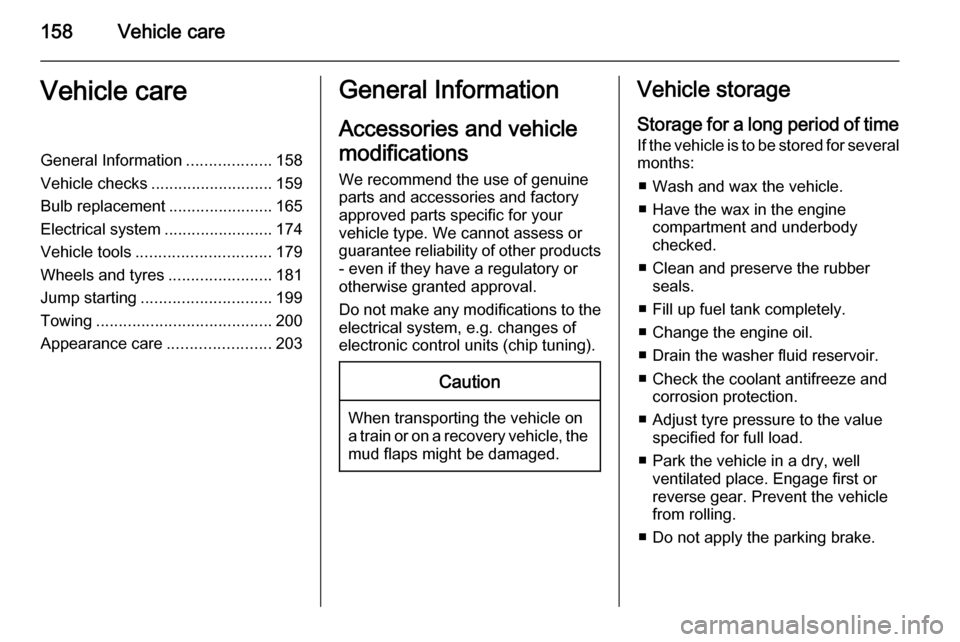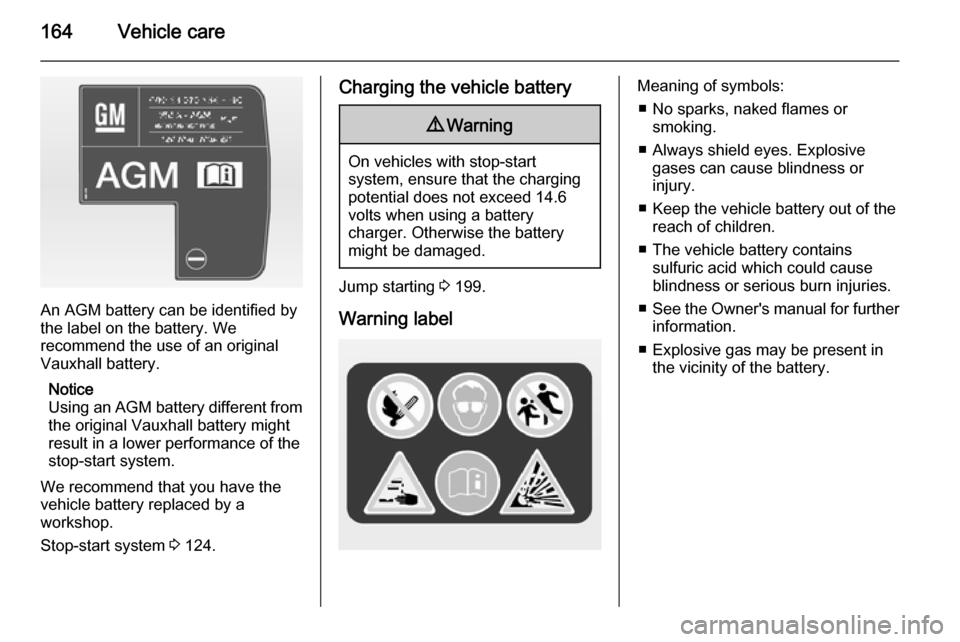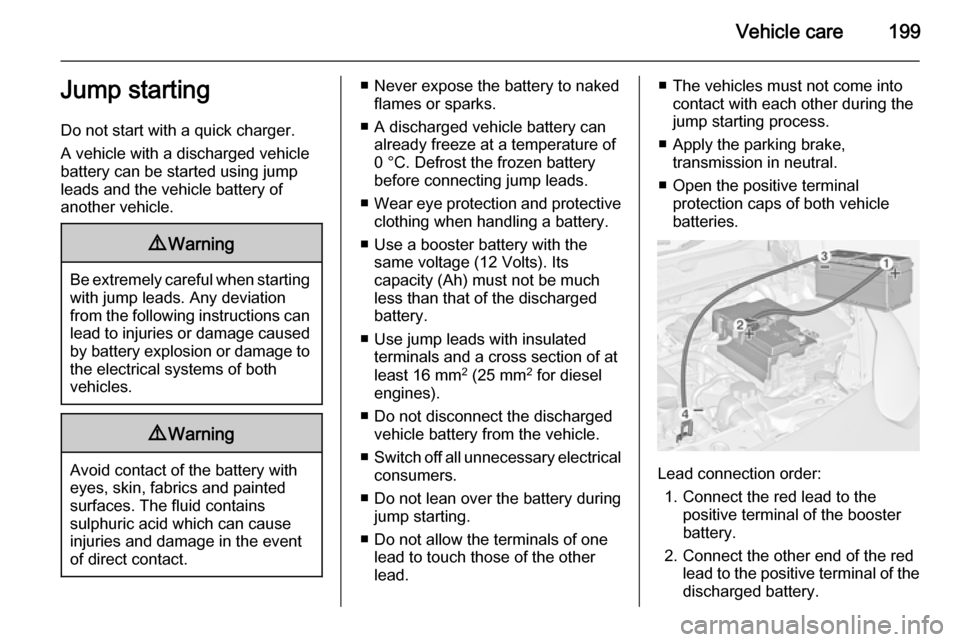jump start VAUXHALL ADAM 2015.5 Owner's Manual
[x] Cancel search | Manufacturer: VAUXHALL, Model Year: 2015.5, Model line: ADAM, Model: VAUXHALL ADAM 2015.5Pages: 233, PDF Size: 6.98 MB
Page 160 of 233

158Vehicle careVehicle careGeneral Information...................158
Vehicle checks ........................... 159
Bulb replacement .......................165
Electrical system ........................174
Vehicle tools .............................. 179
Wheels and tyres .......................181
Jump starting ............................. 199
Towing ....................................... 200
Appearance care .......................203General Information
Accessories and vehicle
modifications
We recommend the use of genuine parts and accessories and factory
approved parts specific for your
vehicle type. We cannot assess or
guarantee reliability of other products
- even if they have a regulatory or
otherwise granted approval.
Do not make any modifications to the electrical system, e.g. changes of
electronic control units (chip tuning).Caution
When transporting the vehicle on
a train or on a recovery vehicle, the
mud flaps might be damaged.
Vehicle storage
Storage for a long period of time
If the vehicle is to be stored for several months:
■ Wash and wax the vehicle.
■ Have the wax in the engine compartment and underbody
checked.
■ Clean and preserve the rubber seals.
■ Fill up fuel tank completely.
■ Change the engine oil.
■ Drain the washer fluid reservoir.
■ Check the coolant antifreeze and corrosion protection.
■ Adjust tyre pressure to the value specified for full load.
■ Park the vehicle in a dry, well ventilated place. Engage first orreverse gear. Prevent the vehiclefrom rolling.
■ Do not apply the parking brake.
Page 166 of 233

164Vehicle care
An AGM battery can be identified by
the label on the battery. We
recommend the use of an original
Vauxhall battery.
Notice
Using an AGM battery different from
the original Vauxhall battery might
result in a lower performance of the
stop-start system.
We recommend that you have the
vehicle battery replaced by a
workshop.
Stop-start system 3 124.
Charging the vehicle battery9 Warning
On vehicles with stop-start
system, ensure that the charging potential does not exceed 14.6
volts when using a battery
charger. Otherwise the battery
might be damaged.
Jump starting 3 199.
Warning label
Meaning of symbols: ■ No sparks, naked flames or smoking.
■ Always shield eyes. Explosive gases can cause blindness or
injury.
■ Keep the vehicle battery out of the reach of children.
■ The vehicle battery contains sulfuric acid which could cause
blindness or serious burn injuries.
■ See the Owner's manual for further
information.
■ Explosive gas may be present in the vicinity of the battery.
Page 201 of 233

Vehicle care199Jump starting
Do not start with a quick charger.
A vehicle with a discharged vehicle
battery can be started using jump
leads and the vehicle battery of
another vehicle.9 Warning
Be extremely careful when starting
with jump leads. Any deviation
from the following instructions can
lead to injuries or damage caused
by battery explosion or damage to the electrical systems of both
vehicles.
9 Warning
Avoid contact of the battery with
eyes, skin, fabrics and painted
surfaces. The fluid contains
sulphuric acid which can cause
injuries and damage in the event
of direct contact.
■ Never expose the battery to naked flames or sparks.
■ A discharged vehicle battery can already freeze at a temperature of
0 °C. Defrost the frozen battery
before connecting jump leads.
■ Wear eye protection and protective
clothing when handling a battery.
■ Use a booster battery with the same voltage (12 Volts). Its
capacity (Ah) must not be much less than that of the discharged
battery.
■ Use jump leads with insulated terminals and a cross section of at
least 16 mm 2
(25 mm 2
for diesel
engines).
■ Do not disconnect the discharged vehicle battery from the vehicle.
■ Switch off all unnecessary electrical
consumers.
■ Do not lean over the battery during jump starting.
■ Do not allow the terminals of one lead to touch those of the other
lead.■ The vehicles must not come into contact with each other during the
jump starting process.
■ Apply the parking brake, transmission in neutral.
■ Open the positive terminal protection caps of both vehicle
batteries.
Lead connection order:
1. Connect the red lead to the positive terminal of the booster
battery.
2. Connect the other end of the red lead to the positive terminal of the
discharged battery.
Page 202 of 233

200Vehicle care
3. Connect the black lead to thenegative terminal of the booster
battery.
4. Connect the other end of the black
lead to a vehicle grounding point,
such as the engine block or an
engine mounting bolt. Connect as far away from the discharged
vehicle battery as possible,
however at least 60 cm.
Route the leads so that they cannot
catch on rotating parts in the engine
compartment.
To start the engine: 1. Start the engine of the vehicle providing the jump.
2. After 5 minutes, start the other engine. Start attempts should be
made for no longer than
15 seconds at an interval of 1 minute.
3. Allow both engines to idle for approx. 3 minutes with the leads
connected.4. Switch on electrical consumers (e.g. headlights, heated rear
window) of the vehicle receiving
the jump start.
5. Reverse above sequence exactly when removing leads.Towing
Towing the vehicle The towing eye is stowed with thevehicle tools 3 179.Adam
1. Disengage the cap by pushing at
the marked position.
Page 230 of 233

228
I
Identification plate .....................211
Ignition switch positions .............123
Immobiliser ............................ 27, 89
Indicators ...................................... 80
Information displays...................... 90
Instrument cluster ........................80
Instrument panel fuse box .........177
Instrument panel illumination .....174
Instrument panel illumination control .................................... 108
Instrument panel overview ........... 10
Interior care ............................... 205
Interior lighting ............................ 108
Interior lights ...................... 108, 174
Interior mirrors .............................. 29
Introduction .................................... 3
ISOFIX child restraint systems ....52
J Jump starting ............................. 199
K Key, memorised settings ..............22
Keys ............................................. 20
Keys, locks ................................... 20
L Lashing eyes ............................... 68
Light switch ................................ 104Load compartment ................25, 64
Load compartment cover .............66
Loading information .....................70
Low fuel ....................................... 89
M
Malfunction indicator light ............86
Manual anti-dazzle ......................29
Manual mode ............................. 131
Manual transmission .................. 128
Manual transmission automated 129
Memorised settings ......................22
Mirror adjustment ........................... 8
Misted light covers .....................108
N
New vehicle running-in ..............122
Number plate light .....................173
O Object detection systems ...........141
Odometer ..................................... 80
Oil, engine .......................... 208, 212
Operate pedal ............................... 87
Outside temperature ....................76
Overrun cut-off ........................... 124
P Parking ................................ 18, 126
Parking assist ............................ 141Parking brake ............................ 133
Parking lights ............................. 107
Performance .............................. 217
Performing work ........................159
Pollen filter ................................. 120
Power outlets ............................... 79
Power steering.............................. 88
Power windows ............................ 29
Puncture ..................................... 191
R Radio Frequency Identification (RFID) ..................................... 224
Radio remote control ...................21
Rear carrier system ......................55
Rear floor storage cover ..............67
Rear fog light ............................... 89
Rear fog lights ........................... 107
Rear storage ................................. 65
Rear window wiper/washer .......... 75
Recommended fluids and lubricants ........................ 208, 212
Refuelling ................................... 153
Retained power off .....................123
Reversing lights .........................108
Ride control systems ..................134
Roof load ...................................... 70
Roof rack ..................................... 70